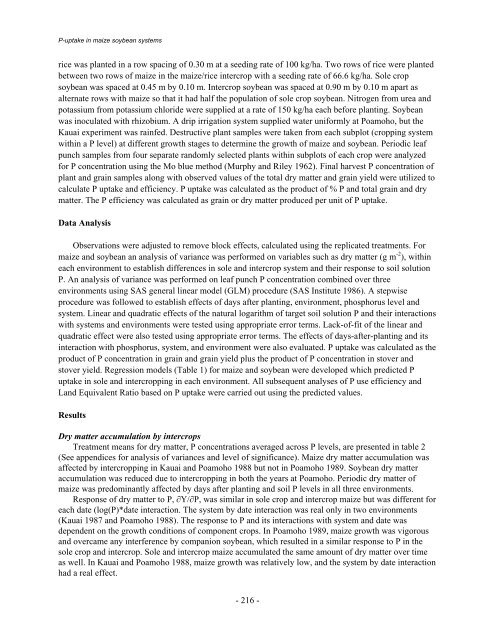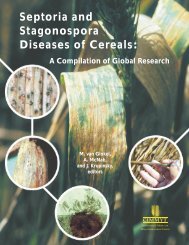Section 3 (Crop Management)
Section 3 (Crop Management)
Section 3 (Crop Management)
Create successful ePaper yourself
Turn your PDF publications into a flip-book with our unique Google optimized e-Paper software.
P-uptake in maize soybean systems<br />
rice was planted in a row spacing of 0.30 m at a seeding rate of 100 kg/ha. Two rows of rice were planted<br />
between two rows of maize in the maize/rice intercrop with a seeding rate of 66.6 kg/ha. Sole crop<br />
soybean was spaced at 0.45 m by 0.10 m. Intercrop soybean was spaced at 0.90 m by 0.10 m apart as<br />
alternate rows with maize so that it had half the population of sole crop soybean. Nitrogen from urea and<br />
potassium from potassium chloride were supplied at a rate of 150 kg/ha each before planting. Soybean<br />
was inoculated with rhizobium. A drip irrigation system supplied water uniformly at Poamoho, but the<br />
Kauai experiment was rainfed. Destructive plant samples were taken from each subplot (cropping system<br />
within a P level) at different growth stages to determine the growth of maize and soybean. Periodic leaf<br />
punch samples from four separate randomly selected plants within subplots of each crop were analyzed<br />
for P concentration using the Mo blue method (Murphy and Riley 1962). Final harvest P concentration of<br />
plant and grain samples along with observed values of the total dry matter and grain yield were utilized to<br />
calculate P uptake and efficiency. P uptake was calculated as the product of % P and total grain and dry<br />
matter. The P efficiency was calculated as grain or dry matter produced per unit of P uptake.<br />
Data Analysis<br />
Observations were adjusted to remove block effects, calculated using the replicated treatments. For<br />
maize and soybean an analysis of variance was performed on variables such as dry matter (g m -2 ), within<br />
each environment to establish differences in sole and intercrop system and their response to soil solution<br />
P. An analysis of variance was performed on leaf punch P concentration combined over three<br />
environments using SAS general linear model (GLM) procedure (SAS Institute 1986). A stepwise<br />
procedure was followed to establish effects of days after planting, environment, phosphorus level and<br />
system. Linear and quadratic effects of the natural logarithm of target soil solution P and their interactions<br />
with systems and environments were tested using appropriate error terms. Lack-of-fit of the linear and<br />
quadratic effect were also tested using appropriate error terms. The effects of days-after-planting and its<br />
interaction with phosphorus, system, and environment were also evaluated. P uptake was calculated as the<br />
product of P concentration in grain and grain yield plus the product of P concentration in stover and<br />
stover yield. Regression models (Table 1) for maize and soybean were developed which predicted P<br />
uptake in sole and intercropping in each environment. All subsequent analyses of P use efficiency and<br />
Land Equivalent Ratio based on P uptake were carried out using the predicted values.<br />
Results<br />
Dry matter accumulation by intercrops<br />
Treatment means for dry matter, P concentrations averaged across P levels, are presented in table 2<br />
(See appendices for analysis of variances and level of significance). Maize dry matter accumulation was<br />
affected by intercropping in Kauai and Poamoho 1988 but not in Poamoho 1989. Soybean dry matter<br />
accumulation was reduced due to intercropping in both the years at Poamoho. Periodic dry matter of<br />
maize was predominantly affected by days after planting and soil P levels in all three environments.<br />
Response of dry matter to P, ∂Y/∂P, was similar in sole crop and intercrop maize but was different for<br />
each date (log(P)*date interaction. The system by date interaction was real only in two environments<br />
(Kauai 1987 and Poamoho 1988). The response to P and its interactions with system and date was<br />
dependent on the growth conditions of component crops. In Poamoho 1989, maize growth was vigorous<br />
and overcame any interference by companion soybean, which resulted in a similar response to P in the<br />
sole crop and intercrop. Sole and intercrop maize accumulated the same amount of dry matter over time<br />
as well. In Kauai and Poamoho 1988, maize growth was relatively low, and the system by date interaction<br />
had a real effect.<br />
- 216 -









